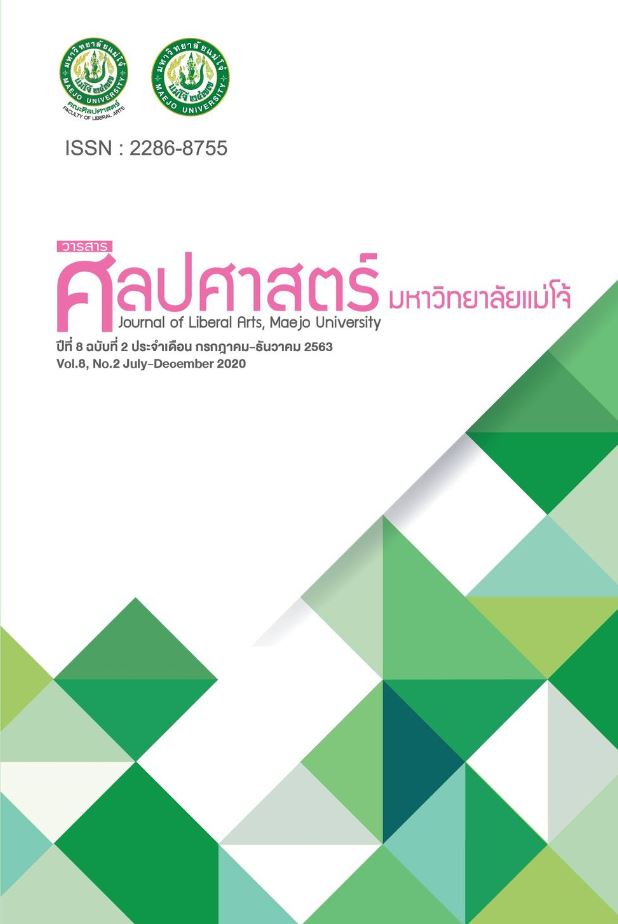Students’ Perspectives toward the Learning of English Phonetics and Phonology and its Application in English for Communication Development
Main Article Content
Abstract
This research attempted to investigate 1) the students’ expectations toward the learning of English phonetics and phonology, 2) their perspectives toward the lesson difficulty, and 3) their self-evaluation toward the improvement of their verbal communication ability. The participants were 141 English-for-International-Communication (EIC) students at the Faculty of Business Administration and Liberal Arts, Rajamangala University of Technology Lanna, Phitsanulok, Tak, Lampang, Nan, and Chiangmai campuses. All of the participants already finished the BOAEC 104 Essential English Phonetics and Phonology for Communication course. The convenient sampling technique intended for participant selection. A researcher-developed questionnaire with an overall Index of Item-Objective Congruence (IOC) value of 0.66 intended to collect quantitative data, and a semi-structured interview with an overall IOC value of 0.84 aimed at gathering qualitative data. The quantitative data were statistically analyzed to find the mean score, percentage, and standard deviation. Content analysis was also available for qualitative data explanations. The results of the study revealed that, on average, the participants had a high expectation (=4.37) in learning English phonetics and phonology. They especially expected the learning to benefit their future lives and increase their confidence in speaking. Considering the lesson difficulty, the participants concurred that, on average, the lessons were difficult (=3.67). However, when the participants were followed up with an interview question, they commented that the lessons were difficult but challenging. Regarding the participants’ self-evaluation, after the completion of the course, the participants reported a high improvement (=3.87) in their verbal communication ability. Clear pronunciation and the ability to use correct stress placement and intonation enhanced their verbal communication ability. The participants also reported the application of learned knowledge in other subjects, such as Public Speaking, Oral Presentation, and Listening-Speaking. Concerning the results of the research, suggested topics in essential English phonetics and phonology have been proposed to promote ELF students’ verbal communication ability. Furthermore, lecturers in English should occupy the specified knowledge of English phonetics and phonology to be able to provide additional help and support to students.
Article Details
References
Burns, A. (2003). Understanding Pronunciation (A. Burns & S. Claire, Eds.). Macquarie University, Sydney NSW: National Centre for English Language Teaching and Research.
Burns, A. (2019). Concepts for teaching speaking in the English language classroom. LEARN Journal: Language Education and Acquisition Research Network Journal, 12(1), 1-11.
Chiang Mai University. (2013). Curriculum of the Bachelor of Arts Program in English Revised 2013 (B.E. 2556). Retrieved from https://www.human.cmu.ac.th/pdf/curriculum/001ENGL.pdf
Fromkin, V., Rodman, R. & Hyams, N. (2007). An introduction to language (8th ed.). The United States of America: Thomson West.
Gilakjani, A. P. (2012). A Study of Factors Affecting EFL Learners' English Pronunciation Learning and the Strategies for Instruction. International Journal of Humanities and Social Science, 2(3), 119-128.
Hayes, B. (2009). Introductory phonology. Oxford: Wiley-Blackwell.
Kanoksilapatham, B. (2016). Pronunciation in action. Nakhon Pathom: Silpakorn University Publishing House.
Kostic-Bobanović, M. & Bobanović, M. (2013). Foreign language skills in business communication. The Proceedings of 32nd International Conference on Organizational Science Development (pp. 415-422). Portorož, Slovenia.
Kracht, M. (2007). Introduction to linguistics. Los Angeles: Department of Linguistics, University of California.
Lintunen, P. & Mäkilähde, A. (2013). Learning English phonetics: preferences and attitudes. In J. Przedlacka, J. Maidment, & M. Ashby (Eds.). The proceedings of the Phonetics Teaching and Learning Conference (pp. 51-55). Phonetics Teaching and Learning Conference: London.
Maejo University. (2017). Curriculum of the Bachelor of Arts Program in English Revised 2017 (B.E. 2560). Retrieved from https://www.libarts.mju.ac.th/LibDocument/Eng/มคอ2_eng_ทั้งเล่ม_สกอ%20(1).pdf
Marzá, N. E. (2014). Pronunciation and comprehension of oral English as a foreign language class: key aspects, students’ perceptions and proposals. Journal of Language Teaching and Research, 5(2), 262-273. doi:10.4304/jltr.5.2.262-273
Marzuki, E., Ting, S. H., Jerome, C., Chuah, K. M., & Misieng, J. (2013). Congruence between language proficiency and communicative abilities. Procedia - Social and Behavioral Sciences, 97, 448-453. doi: 10.1016/j.sbspro.2013.10.258
Mompeán, J. A., Ashby, M., & Fraser, H. (2011). Phonetics teaching and learning: an overview of recent trends and directions. The Proceedings of the 17th International Congress of Phonetic Sciences (ICPhS XVII) (pp. 96-99). City University of Hong Kong: Hong Kong.
Naresuan University. (2017). TQF 2 Bachelor of Education Program in English (5-year program) Revised 2017 (B.E. 2560). Retrieved from https://www.edu.nu.ac.th/th/course/download/beng.pdf
Naresuan University. (2018). Curriculum of the Bachelor of Arts Program in English Revised 2018 (B.E. 2561). Retrieved from https://www.human.nu.ac.th/th/english/files/bachelor-english.pdf
Phonhan, P. (2019). Strategies in English Oral Communication Employed by Thai Engineering Students across Majors and Types of Academic Programs. Journal of Liberal Arts, Maejo University, 7(1), 152-174.
Pibulsongkram Rajabhat University. (2012). Curriculum of the Bachelor of Education Program in English (5-year program) Revised 2012 (B.E. 2555). Retrieved from https://edu.psru.ac.th/v2016/courseBD_English.php#tab1
Pibulsongkram Rajabhat University. (2017). Curriculum of the Bachelor of Arts Program in English Revised 2017 (B.E. 2560). Retrieved from https://huso.psru.ac.th/2017/course/หลักสูตรภาษาอังกฤษ-60.pdf
Powers, D. E. (2010). The case for a comprehensive, four-skills assessment of English language proficiency. Retrieved from https://www.ets.org/Media/Research/pdf/TC-10-12.pdf
Rajamangala University of Technology Lanna. (2017). TQF 2 Bachelor of Arts Program in English for International Communication Revised 2017 (B.E. 2560). Retrieved from https://webs.rmutl.ac.th/assets/upload/files/2019/03/20190308153053_16517.pdf
Sadiku, L. M. (2015). The importance of four skills reading, speaking, writing, listening in a lesson hour. European Journal of Language and Literature Studies, 1(1), 29-31.
Sahatsathatsana, S. (2017). Pronunciation problems of Thai students learning English phonetics: a case study of Kalasin University. Journal of Education, Mahasarakham University, 11(4), 67-84.
Sheth, T. (2016). Expressive communication skills in English: a criterion for non-native L2 students. International Journal of Humanities Social Sciences and Education (IJHSSE), 3(12), 43-47. https://dx.doi.org/10.20431/2349-0381.0312005
Timyam, N. (2010). An introduction to English linguistics. Bangkok: Department of Foreign Languages, Faculty of Humanities, Kasetsart University.
Yule, G. (2010). The study of language (4th ed.). New York: Cambridge University Press.
Zsiga, E. (2006). The sounds of language (Ralph W. Fasold & Jeff Connor-Linton, Eds.). Barcelona: Grafos S.A. Arte Sobre Papael.

